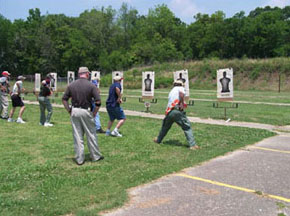
By Syd
Pistols are inherently difficult to use effectively.
Some people are born with talent and good instincts, but no one is born with fighting skill.
Pistolcraft is a perishable skill.
You fight like you train.
Training. Training. Training. Be honest with yourself for a minute. No one else is listening. If you were called upon to defend yourself, your family, right now, would your skills and equipment be up to the task? I suppose that the really dedicated warrior type would have to give a “Yes, but…” kind of answer, knowing that he had done everything he could do to prepare himself, and yet he would know that complacency could be deadly. For most of us, the answer would probably be something more along the lines of, “Well, I need to get out to the range…”
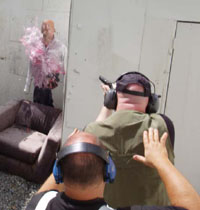
If one’s only exposure to the art of combat pistolcraft is from the gun mags and the Internet, it would be easy to get the impression that defensive pistol is matter of buying the latest and greatest pistol and stoking it with Brand XYZ Super Death Ray ammunition. And yet, if you happen to meet a real master gunfighter, you are likely to find that the gun is missing some finish from many thousands of draws and it is on its third barrel. The ammo may turn out to be some boring generic stuff that always works and he was able to get a really good deal on ten cases. The most important feature of the gun will be that it goes bang every time the trigger is pulled. It probably won’t be a new gun and it probably wasn’t the featured beauty spread in American Handgunner last month.
The masters practice a lot. They work on the fine points. They compare ideas with other experts. They study the craft and the dynamics of fights. But mostly, they send a lot of rounds downrange. They don’t just shoot a lot. They move while they’re shooting. They practice using cover and shooting from weird angles and positions. They practice malfunction recovery and reloads. Those who have actually “seen the balloon go up” will place heavy emphasis on not getting shot.
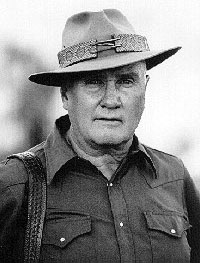
Pistols are inherently difficult to use effectively. There are two parts of this that are interrelated but different. The first part is mechanical: the small size of pistols and the way we hold them make it more difficult to hit accurately compared to a long gun. The second factor is that pistol ammunition is not very effective so it is critically important to get good hits with a pistol in order to stop an attacker. The hit zone which a bullet must strike to stop an attacker is pretty small. We all grew up with media images of cowboy quick-draw artists snapping their guns out of the holster, firing from the hip and disabling or disarming the bad guy with a perfectly placed bullet. There are a few rare individuals who can do shots like that, but most of us mere mortals can’t.
Most of us need to work at just getting good hits fast enough to have a chance of staying alive. Often, when we start shooting pistol on our own without any skilled guidance, we develop bad habits like “milking the trigger” and flinching when we pull the trigger. A skilled trainer can watch you shoot and help diagnose shooting mistakes. One of my own was hooking the trigger in my first knuckle rather than pressing the trigger with the center of my finger pad. Once an experienced shooter pointed that out to me, my accuracy improved dramatically. It was a small thing, but it really mattered.
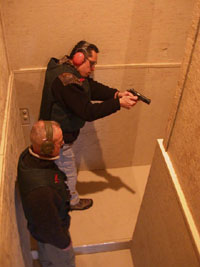
Some people are born with a great deal of natural ability – good eyes, good reflexes, strength and innate athletic ability. It’s wonderful to be blessed with such things, but unless one is also blessed with clairvoyance, there are techniques and methods to defensive pistolcraft which must be learned from someone who knows them. We aren’t born with them. Innate athletic ability is negated if the attacker gets off a lucky shot which hits you between the eyes, or if your gun runs dry at precisely the wrong time. There is a body of knowledge to pistolcraft that you have to acquire, such as how to use cover, when and how to reload, how to move and shoot and what the tactical priorities are. And once learned, these things have to be practiced until you can do them in your sleep. One might come to all of these things alone by intuitive means, but why chance it? A good teacher can save you a lot of time, give you insights you might not come to on your own, and let you know if you’re on the right track.
I’m going to take off my Second Amendment advocate hat for a second (You know, the hat that makes you say ‘all people have the right to bear arms and possess an adequate means of self defense.’) and put on my gun elitist cap for a while. There are some folks who have bought pistols and are carrying them who don’t have a clue about how to use them. (I hate even committing a thought like that to paper because I know some sniveling troll from the Brady Campaign will pick it up and quote me, but sometimes you have to call them like you see them..) I don’t want to condemn any inexperienced person who chooses to get a pistol and carry it, but I do feel strongly that the decision to carry a pistol implies a commitment to learn how to use it safely and effectively. I want new and inexperienced people to acquire self defense pistols and carry them, but I also want them to train and practice so that they can employ those pistols competently. You fight like you train, and by implication, if you don’t train, you don’t fight very well. Without training and practice, you may get lucky and survive, but do you really want the well-being of yourself and your loved ones riding on luck?
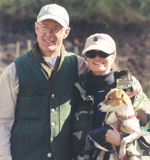
Pistolcraft is a perishable skill. The best analogy is that of a musical instrument. Even the most highly accomplished musicians need to practice every day to keep their skills sharp, and most do. It may not be feasible to go to the range and shoot every day, but a regular practice regimen is necessary to maintain your effectiveness with a defensive pistol. If you lay off and don’t shoot for weeks or months, you skills will deteriorate significantly.
“Shooting skill is lost more quickly than we would like to admit, and unless you keep up your practice you cannot expect to maintain your command of the situation. I find this to be more true of the pistol than the rifle…” – Jeff Cooper, Commentaries, June 1996
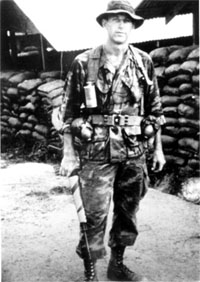
You fight like you train. Barrett Tillman said, “You won’t rise to the occasion – you’ll default to your level of training.” This is true. Physiologists, psychologists, and survivors of violent encounters tell us that a whole witch’s brew of things happen to our bodies and minds in the stress of a violent encounter. There is the “adrenaline dump” in which the body is flooded with this powerful hormone/neurotransmitter. Its effects are: increase in the rate and strength of the heartbeat, dilation of bronchi and pupils, vasoconstriction, sweating and reduced clotting time of the blood. Blood is shunted from the skin and viscera to the skeletal muscles, coronary arteries, liver and brain. Psychologists tell us that in times of extreme stress, the unconscious balloons to fill our whole consciousness. (The theory is that the repository of survival instincts, “muscle memory,” learned responses and emergency reflexes is the unconscious part of the mind.) Survivors report temporal and auditory distortion and a narrowing of the field of vision. None of this is conducive to a high level of marksmanship. Overall, our performance is thought to degrade by about 30% if not more. An emergency is not the venue to work out new fighting techniques. As Tillman says, “You’ll default to your level of training.” In the investigation following the tragic CHP Newhall gunfight that left four CHP officers dead, it was found:
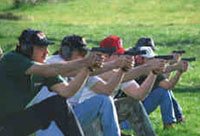
“…that officers would react to a situation exactly the way they were taught in training. This occurred with Officer Pence. After Officer Pence had fired his sixth and last round, he tried to perform and reload just the way he was taught at the academy. He dumped the expended rounds from his revolver into his right hand and put the expended rounds in his pants pocket, as he had done on the firing range, then reloaded 6 rounds into his revolver. This gave Twining enough time to flank Pence and put a bullet in the back of his head. After the California Highway Patrol learned of this they issued speed loaders to their officers and changed their firearms training program to reflect real life shooting scenarios.”
– Tom Kohl, STAYING ALIVE ON THE JOB – A SURVIVAL GUIDE FOR PEACE OFFICERS
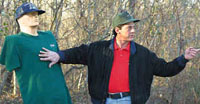
I relay this sad anecdote only because Pence’s empty brass has stuck in my mind for a long time, and it is a most graphic and emblematic image of the principle that we fight like we train. Even when it makes no sense, even when it may be the wrong thing to do, we tend to default and revert to the methods we have practiced and rehearsed. By inference, we could suggest that if the only way you ever fire your gun is standing flat footed in the Isosceles stance at the range, you will most likely shoot that way in an emergency. This, of course, provides your adversary with a superb stationary target. To survive a fight, you must train on the right things, and train well, and hopefully with someone who has “seen the balloon go up.”

A note about gun games: By “gun games” I mean the organized “practical” pistol matches such as IPSC and IDPA. I love these matches. They’re fun, good fellowship, and decent marksmanship practice. They’re good for testing guns and gear. They are not, however, genuine tactical training, and to confuse the two could be dangerous. Each of these disciplines began as “practical” defensive pistol competition intended to simulate gunfights to a certain extent. The hope was that by practicing defensive pistol scenarios, shooters would be better equipped for the real world. Human nature being what it is, the competitive sporting side of the thing eclipsed the practical. What we got was a highly stylized athletic event that tends to neglect important tactical issues. For
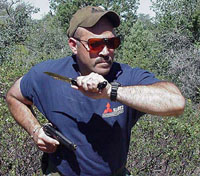
example, a target is neutralized in IDPA when two rounds are placed in the saucer sized area in the middle of the target; in the real world, the target is neutralized when he’s out of the fight, and it may take one round or ten. At the end of an IDPA stage, the shooter must “unload and show clear.” At the end of a real engagement, the shooter should be reloading and scanning 360° because he doesn’t know if this is the end or not. (This will of course, get you ejected from an IDPA match for breaking the 180 rule.) In an IDPA match, effective use of cover is considered to be when 50% of your A-zone is behind hard cover. In the real world, that still leaves a lot of you uncovered to shoot. I could go on, but I think you get the idea. I’m not saying that IDPA-style matches have no training validity – they’re a whole lot better than not practicing and good social interaction to boot – but it’s important to distinguish that which is not real about them and practice the correct techniques so that we can fight like we train.
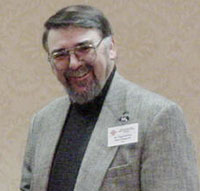
You may be thinking right now, “OK, you’ve made your case, but how do I find a good trainer?” That can be difficult, but not impossible. There are quite a few talented trainers around the country. There are several training facilities which have maintained excellent reputations for many years. A number of the top level trainers travel around and conduct classes for gun clubs and the better ranges. There are also a fair number of gun shop commandos and posers that have to be sorted out. If you participate with local shooting organizations you can often get referrals from fellow shooters. Sometimes the gun mags (who are not always corrupt whores) will carry stories about trainers or facilities. There are several training facilities that have achieved almost legendary status in the mind of hand gunners. There is, of course, the mother ship, Gunsite, founded by Jeff Cooper. Also, there is Thunder Ranch, Yavapai, Range Master, Blackwater, and The Lethal Force Institute.
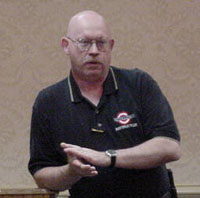
How do you identify the trainer who is right for you? The recommendations of people you trust and respect is one excellent way. Another important tool is your own intuition and gut-level feelings. Does the guy’s understanding of the world around you square with yours? Can you work with him? Ask him questions? Get the answers that help you? Does he seem excessively blood-thirsty or too cautious? I personally don’t like the guys who come off with the “combat god” attitude, although if they’re really excellent at what they do, I’ll endure the attitude. On the other hand, guys who are too cautious and only seem to want to talk you out of ever using you pistol put me off too (These are often retired cops who would almost rather die than go through another grand jury hearing – but even they have something important to say and should be heard). I would consider a complete lack of military or law enforcement experience a red flag. Personally, I prefer to work with guys who use M1911 pistols, but I have met some very talented people who use Glocks and SIGs. And while it probably doesn’t need to be said, is the guy good enough with a pistol that you are going to learn something from him?
When most of us hear the expression, “martial arts,” we tend to think of Bruce Lee and Kung Fu. Defensive pistolcraft is a martial art too, and shares with the traditional martial arts many of the same requirements and disciplines. I don’t want to push the analogy too far, but like the traditional martial arts, pistolcraft requires self discipline, a sense of the seriousness of the purpose, a regular regimen of practice and study, a willingness to set aside your own ego long enough to learn something, and a certain reliance upon the master-student system. Jeff Cooper could be said to be the “guru” for our whole generation of pistol shooters with his development of “The Modern Technique of the Pistol” and the founding of Gunsite. Perhaps I should say that defensive pistolcraft benefits from a master-student system. A lot of the old time legendary gunfighters like Bill Tilghman, Bill Jordan and Charlie Askins, and even Cooper, didn’t have schools and training facilities to learn their tricks. It is possible to teach yourself, and if you’re lucky and have a lot of innate talent you may be successful. However, you can save time and risk, and have a lot of fun in the process, by working with good trainers in an organized instructional setting.

Comments, suggestions, contributions? Let me know